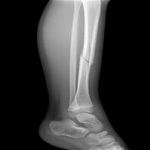
There are many types of fracture, or otherwise known as a broken bone, and different ways each can occur. If you’ve cracked or broken a bone, it’s fractured.
Some fractures can be more damaging than others. Broken bones are caused by a force applied against a bone that is stronger than it can handle. “Common bone fractures occur in the wrist, ankle and the hip.”
The severity of the fracture depends on how much damage is done, and the location. The most common causes of a broken bone are trauma, overuse, and osteoporosis.

Types of Fractures
- Closed (simple) fracture – Fracture has not pierced the skin.
- Open (compound) fracture – Broken bone protrudes the skin.
- Greenstick fracture – A slender crack in the bone. This is common in children because their bones are so flexible.
- Hairline fracture – The most common form of a stress fracture.
- Complicated fracture – The structures surrounded the fracture become injured.
- Comminuted fracture – Bone becomes shattered into small pieces.
- Avulsion fracture – Muscle contractions can jerk the tendon and pull out a piece of the bone.
- Compression fracture – When two bones are forced together.

Treatment
- Splints
- Braces
- Casts
- Traction
- Surgery
Occasionally (given the severity of the fracture), the bones must be surgically fixated. This will ensure the bones are placed in their proper placement. The most common surgeries for fractures are manipulation (reduced), closed reduction and open reduction.
So how long does it take for a fracture to heal?
Children are able to heal and remodel fractures faster than adults. Factors that can affect bone healing are smoking, Diabetes and the use NSAID’s. There are some studies showing that these factors may slow down bone healing.
Fractures do not heal overnight. Your doctor will obtain radiographs (x-rays) of the fracture site to ensure there is healing. Usually around 6 weeks you will begin to see callus formation (bone healing), and most of the time at 12 weeks the fracture is healed.
Source
http://www.webmd.com/a-to-z-guides/understanding-fractures-basic-information
http://www.betterhealth.vic.gov.au/bhcv2/bhcarticles.nsf/pages/Bone_fractures
http://www.webmd.com/a-to-z-guides/understanding-fractures-treatment

